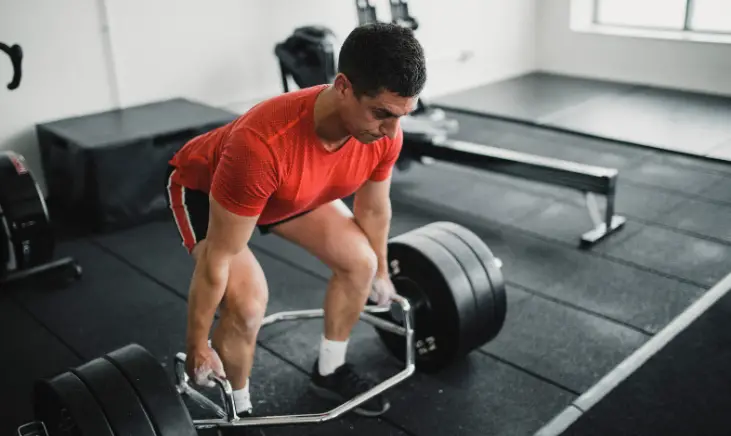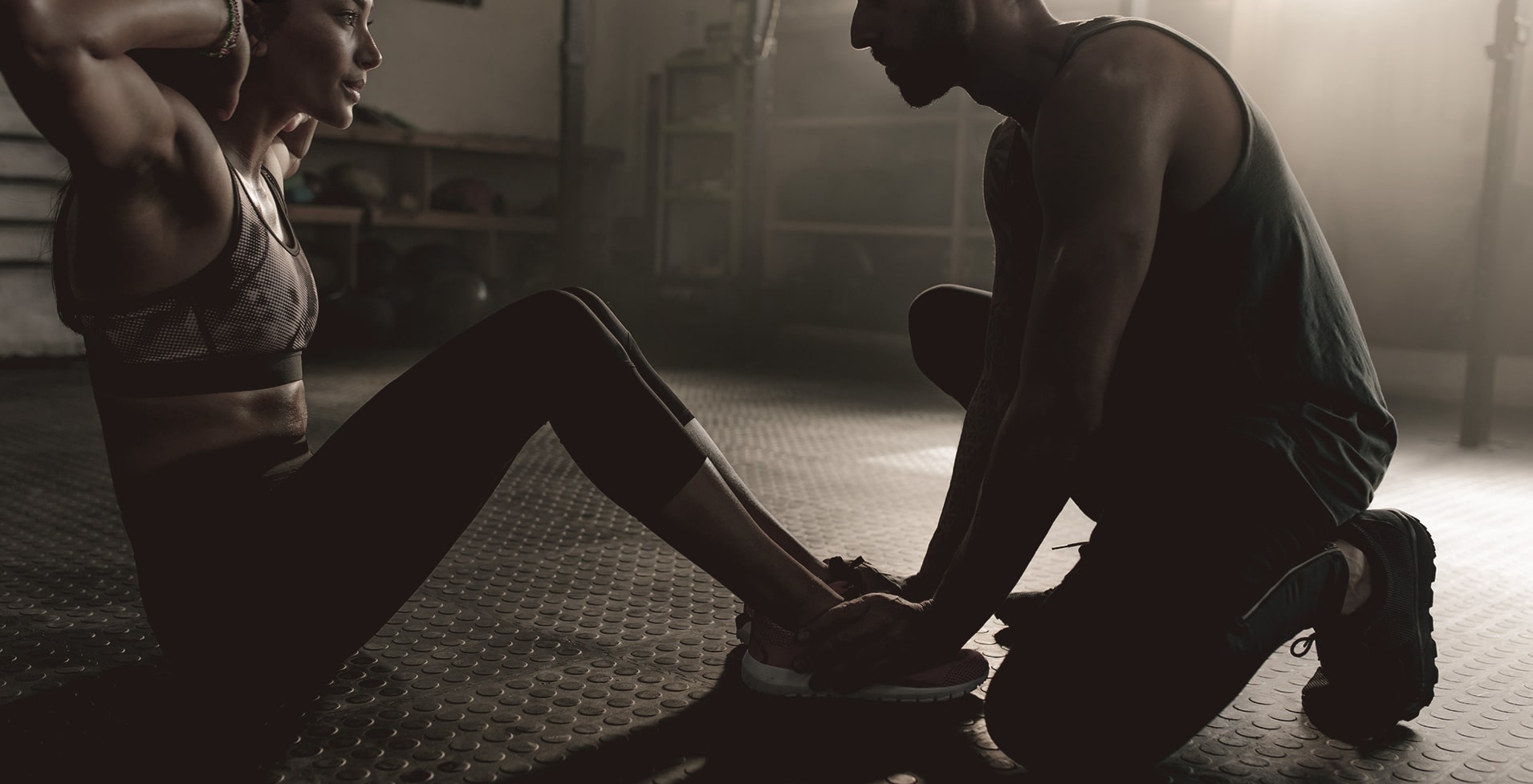Whether you’re a fitness enthusiast, a powerlifter, or someone merely wanting to lift heavier weight in the gym, trap bar deadlifts are the perfect addition to your gym routine!
The hex bar, or hexagonal bar, is a specialty bar typically found in most commercial gyms or athletic training spaces.
This piece of gym equipment is also frequently referred to as a trap bar. One popular exercise with this equipment is called a trap bar deadlift, which is widely known for its effectiveness in hitting a large majority of muscle groups like the quads, glutes, and erector spinae. Trap bar deadlifts are an excellent exercise for beginners and veterans alike.
In this article, we’ll share numerous trap bar deadlift benefits and how to incorporate trap bar deadlifts into your gym regimen!
Table of Contents
What are the Benefits of the Trap Bar Deadlift?
There are many trap bar benefits that more people need to know about to reap the advantages of this powerful exercise. We will detail the benefits of trap bar deadlifts and how they can help you, whether you’re an athlete, a powerlifter, or your average gym goer!

Easier to Lift Heavier Weights
When comparing trap bar deadlifts to traditional barbell deadlifts, many people find it easier to lift heavier weight. It is easier to add more weight plates to a trap bar deadlift than a traditional straight bar deadlift. There are a few reasons why.
One of the biggest reasons is the alternation in grip. A hex bar deadlift incorporates a neutral grip with palms facing you on your sides. For a traditional barbell deadlift, a pronated grip, also called overhand, with palms facing down is frequently used.
Other forms of grip used in barbell deadlifts, like a mixed, snatched, supinated, or hook grip, can be incorporated with straight bar deadlifts depending on the individual’s preferences.
One study showed that athletes were more inclined to lift heavier weights with significantly greater overall velocity, power, and force production with a hex bar compared to a traditional deadlift with a straight barbell. If your goal is to increase strength, then a trap bar is an excellent addition to your fitness routine as one of the top eight types of deadlifts for a dynamic gym routine.
Prevents Lumbar Hyperextension
Low back pain is a common issue for many people; unfortunately, some exercises can cause or intensify it. Regarding the hex bar deadlift vs. traditional deadlift, one places less stress on the lumbar spine than the other.
The trap bar deadlift is safer for your back than a traditional barbell deadlift because there is no hyperextension of the lumbar spine.
Although a neutral spine is part of the proper form for a barbell deadlift, one study showed that even with this prioritization of a neutral spine, there were still natural spinal alignment adjustments of the lumbar spine made while performing the exercise. Such risks are still being evaluated, but for individuals who already suffer from pain in the lower back, this may aggravate existing injuries.
Engages the Quad Muscles More
A trap bar deadlift engages the leg muscles more effectively than a straight bar deadlift.
A particular study evaluated muscle activation differences between the two, finding that trap bar deadlifts activated the vastus lateralis significantly greater than straight bar deadlifts. For reference, the vastus lateralis is the largest muscle of the quadriceps, making up the lateral side of the thigh.
Individuals seeking to improve leg strength or muscle development can use trap bar deadlifts to appropriately engage the leg muscles rather than the straight bar deadlift. This is a more effective maneuver for incorporating the leg muscles in the movement and avoiding any strain or injury risk on the biceps or back.
One of the Most Powerful Lower Body Exercises
Training legs is vital for maintaining leg strength, but unfortunately, many individuals avoid training with the barbell squat, a main lift recognized for incorporating a wide range of muscles. This can be because of issues with back pain, ankle mobility limitations, or knee pain. For beginners, barbell squats can be overwhelming to incorporate into their routine.
That’s where a trap bar deadlift workout can make up for a lack of barbell squats in one’s gym regimen!
Trap bar deadlifts are a powerful lower-body exercise that can compensate for a lack of barbell squats or other leg exercises. Of course, it’s always important to include other exercises like lunges and barbell hip thrusts to provide different stimuli for the leg and glute muscles.
Even so, trap bar deadlifts are a great exercise that activates most of the muscle groups in the lower body to make up for replacing straight bar deadlifts and barbell squats–or simply an excellent addition to both of these exercises!
Great for Beginners
Learning trap bar deadlift form is easier for beginners compared to barbell deadlifts. Barbell deadlifts can be challenging to get used to compared to the hexagonal bar deadlift, which is relatively easy to lift with good form thanks to its simple arm position and better load placement.
The proper form for a hex bar deadlift involves a neutral grip with hands facing you on either side. A more upright torso position is necessary because of the greater knee flexion required for a trap bar deadlift than a barbell deadlift.
How to Perform a Trap Bar Deadlift:
- Stand in the center of the hex bar with feet shoulder-width apart.
- Maintain a neutral spine with arms straight, engage your core throughout the movement, and keep a slight bend in your knees.
- Hinge your hips back as you lower down to grab the trap bar handles with palms facing your sides.
- For your first repetition, think of driving your feet into the ground and driving up through your hips as you return to a standing position.
- Hinging the hips, lower back down until the plates on either side of the hex bar tap the ground.
- This is one repetition.
Lower Risk of Biceps Tears
With trap bar deadlifts, there is a lower risk of biceps tears because of the lower activation of these muscles during the movement. The same can’t be said for barbell deadlifts, which have a higher risk of bicep tears.
The previous study on the difference in muscle activation between a straight bar deadlift and a trap bar deadlift found greater use of the biceps in the concentric phase and the erector spinae in the eccentric phase only with a straight bar deadlift.
This is no surprise because back pain and bicep tears are well-known risks of deadlifting with a straight bar. Another study observed the rate of risk of distal biceps brachii tendon ruptures during the straight bar deadlift to determine an alternative lifting form to lessen this injury risk.
Simple Adjustment Between High and Low Handles
For conventional barbell deadlifts, no customizations can be made for height adjustments. This can be inconvenient because a taller person will require a greater range of motion than a shorter person to complete a straight bar deadlift.
A trap bar deadlift has low and high handles for easier adjustment; the high handles are great for taller individuals and beginners.
A lower bar height can feel more like a deficit pull for taller people because they have to move down lower than an average or shorter person. If the taller person also has mobility issues, it can feel almost impossible to complete a regular bar height deadlift, or this movement can cause strain on areas that have mobility concerns. The higher handles on a hex bar are the perfect customization for these taller individuals to perform a typical range of motion for a deadlift.
Beginners may find the higher handles less challenging as the range of motion isn’t as great. These individuals can use the high handles to grow stronger in the movement before eventually moving down to the low handles on the hex bar.
The low handles on a trap bar are positioned at the center of the weight plates like a traditional straight barbell. Performing a trap bar deadlift with a low handle grip requires a greater range of motion. For individuals looking to increase strength through a broader range of motion, the low handles are ideal if you have the strength, mobility, and form to complete the movement.
Improvements in Grip Strength
For straight bar deadlifts, it can be difficult to maintain one’s grip when lifting more weight. This is because of the shift in weight during the movement–the bar can roll out of your hands if your grip strength isn’t great enough.
Lifters incorporate lifting straps or a mixed grip when struggling to keep the barbell in their hands when lifting heavier weights. Unfortunately, for powerlifters who compete, the use of lifting straps is not permissible in competitions. A mixed grip when lifting is often associated with muscular imbalances, especially if the lifter doesn’t actively switch hand positions to combat this concern when deadlifting.
The great thing about the trap bar deadlift is that the bar won’t roll out of your hands like in a conventional deadlift. This is because of the neutral grip positioning available for hex bar deadlifts, meaning no mixed grip imbalances to be worried about thanks to the improvements in grip strength.
Beneficial for Increasing Power
Adding trap bar deadlift work into your gym routine can be extremely beneficial if you aim to increase power output. Athletic trainers frequently incorporate trap bar deadlift training into assigned workout regimenss because of its efficiency in developing power.
A research study examined the efficacy of a hexagonal barbell on the mechanical demand of deadlift performance to evaluate this claim. Results showed that participants could lift significantly greater loads with greater mean force and power in the hexagonal deadlift than in the conventional barbell deadlift.
Great for Improving Vertical Jump
Another reason why trap bar deadlifting training is prioritized for athletes is its capacity to improve vertical jump. As previously discussed, this lower body exercise promotes better access to power and strength than barbell deadlifts.
To perform deadlifts with the trap bar to increase vertical jump, it is recommended to use explosive movements. The trap bar deadlift is excellent for training proper engagement of the glutes while practicing deceleration that would be used for vertical jumping movements. Plus, the range of motion in a trap bar deadlift is just the right amount for properly training the body to be explosive and achieve progress.
Trap Bar Deadlift Benefits – Which Muscles Are Worked Overall?
The trap bar deadlift benefits are outstanding, shown by its improvements in training for strength, power, and velocity. Knowing which muscles are activated throughout the movement can give you a better idea of how productive this exercise is and why you should add it to your gym routine for overall better fitness progress.
The primary muscle groups incorporated in a trap bar deadlift include:
- Spinal erectors
- Quadriceps
- Hamstrings
- Glutes
The secondary mover muscles, which share the load with the primary mover muscles, include:
- Forearm
- Trapezius
- Adductors
- Abductors
- Gastrocnemius
- Latissimus Dorsi
- Abdominal Muscles
- Rhomboideus

Frequently Asked Questions (FAQ)
Is the Trap Bar Deadlift Better than the Barbell Deadlift?
The barbell and trap bar deadlift are great exercises with different pros and cons.
The trap bar deadlift is your best bet to strengthen attributes like power and vertical jump or to significantly engage the leg muscles. The traditional barbell deadlift is better for activating and strengthening the spinal erectae and hamstrings than the trap bar deadlift.
Why Do People Use the Trap Bar For Deadlift?
The trap bar deadlift is associated with a variety of benefits which is why many people incorporate it into their workout routines.
It is an excellent alternative to a conventional barbell deadlift as the neutral grip makes it easier to maintain grip. This exercise is also beneficial for beginners because it is easy to learn proper form and for taller individuals because the high handlebars better fit the typical range of motion for a deadlift.
How Much Does the Trap Bar Weigh?
A traditional deadlift barbell weighs about 45 lbs while a trap bar weighs around 55 lbs. The additional weight is due to the difference in design for the trap bar which includes a low and high handlebar.
Wrap Up
The trap bar deadlift is linked to many fitness benefits, such as better engagement of the quadriceps and significant increases in power.
Whether you’re an athlete desiring to increase power or a gym goer trying to improve overall leg strength, the trap bar deadlift is an excellent addition to your fitness routine. Try out the trap bar deadlift next time you go to the gym, but start slow when incorporating a new exercise to dedicate time to practicing proper form to avoid any potential injuries. Once you’ve got it down pat, you can reap the benefits of this powerful leg exercise!














